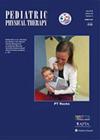评估与婴儿集装箱有关的活动和游戏机会与限制。
IF 1.3
4区 医学
Q3 PEDIATRICS
引用次数: 0
摘要
目的容器(如婴儿推车、婴儿摇椅)是婴儿生活环境的重要组成部分,但可能会对婴儿的发育和健康产生负面影响。本研究评估了婴儿容器的运动和游戏机会、限制因素以及制造商对婴儿容器的发展要求。方法通过 Amazon.com 查找容器。结果分析了 460 个容器的内容。容器的运动和游戏机会各不相同;但是,大多数容器都没有玩具,而且限制了躯干运动、自主运动以及独立的头部和躯干控制。这些研究结果表明,在不同类别的婴儿容器之间和容器内部,运动和游戏机会存在差异。关于容器使用的一般性建议可能不如向家长提供有关选择和使用容器的更具体的教育更有效。本文章由计算机程序翻译,如有差异,请以英文原文为准。
Evaluation of the Movement and Play Opportunities and Constraints Associated With Containers for Infants.
PURPOSE
Containers (eg, strollers, bouncers) are an important part of infants' environment but may negatively impact infant development and health. This study evaluated movement and play opportunities, constraints, and manufacturers' developmental claims for infant containers.
METHODS
Containers were identified through Amazon.com. A content analysis of identified products was conducted to identify movement and visual-manual play opportunities, constraints, and developmental claims.
RESULTS
Content was analyzed for 460 containers. Containers varied in their movement and play opportunities; however, most did not incorporate toys and restricted trunk movement, self-directed locomotion, and independent head and trunk control. Containers, especially those with built-in toys, often had claims related to gross motor, sensory, and fine motor development.
CONCLUSION
These findings demonstrate the variability of movement and play opportunities observed across and within categories of infant containers. General recommendations about container use may be less effective than more specific education to parents about selecting and implementing containers.
求助全文
通过发布文献求助,成功后即可免费获取论文全文。
去求助
来源期刊

Pediatric Physical Therapy
PEDIATRICS-REHABILITATION
CiteScore
1.50
自引率
18.80%
发文量
147
审稿时长
>12 weeks
期刊介绍:
Pediatric Physical Therapy is an indexed international journal, that publishes peer reviewed research related to the practice of physical therapy for children with movement disorders. The editorial board is comprised of an international panel of researchers and clinical scholars that oversees a rigorous peer review process. The journal serves as the official journal for the pediatric physical therapy professional organizations in the Netherlands, Switzerland, New Zealand, Canada, and the United States. The journal includes articles that support evidenced based practice of physical therapy for children with neuromuscular, musculoskeletal, cardiorespiratory and developmental conditions that lead to disorders of movement, and research reports that contribute to the foundational sciences of pediatric physical therapy, ranging from biomechanics and pediatric exercise science to neurodevelopmental science. To these ends the journal publishes original research articles, systematic reviews directed to specific clinical questions that further the science of physical therapy, clinical guidelines and case reports that describe unusual conditions or cutting edge interventions with sound rationale. The journal adheres to the ethical standards of theInternational Committee of Medical Journal Editors.
 求助内容:
求助内容: 应助结果提醒方式:
应助结果提醒方式:


